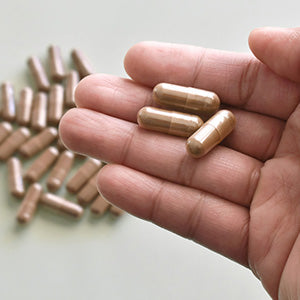Are You Suffering from Sick Building Syndrome?

Sick building syndrome refers to ailments that occur as a result of spending long periods of time in well-sealed, poorly ventilated buildings that contain indoor air toxins. In 1984, the World Health Organization reported that the materials used in up 30% of newly built buildings might cause acute illness. [1] That means that, as of 1984, almost a third of all buildings were contaminated with harmful products! Unfortunately, with the continued use of synthetic building materials, the situation has only gotten worse.
Toxins present in "sick" buildings include synthetic fibers from furniture, formaldehyde, dust mites, cigarette smoke, and VOCs, just to name a few. It's not limited to chemical pollution, either. According to the American Phytopathological Society, biological contaminants such as mold and pollen also contribute to indoor air pollution. [2]
Common Causes of Sick Building Syndrome
- Synthetic insulation
- Poor circulation and lack of fresh air
- Smoke
- Paint fumes
- Dust mites
- Synthetic carpet outgassing
- Pet dander
- Toxic household cleaners
- Fabric outgassing
- Natural gas and carbon dioxide
- Construction materials
- Bacteria from toilet bowl
- Mold and mildew
- Lead or toxic paint
- Carbon monoxide
- Oil and gas fumes
Symptoms Related to Sick Building Syndrome
Common symptoms of sick building syndrome include headache, irritated throat, itchy eyes and nose, coughing, nausea, and fatigue. As you can see, the symptoms are generic and varied, which makes it especially difficult to pinpoint sick building syndrome as the cause. One of the most problematic issues related to sick building syndrome is that it often goes misdiagnosed and untreated. Many people assume their illness is the result of a "bug" and fail to consider their home or workplace is the cause. A telltale sign are ailments that flare up when you are in a specific building and pass after you leave. Another indication is if your colleagues experience similar issues.
If your symptoms are prolonged, even beyond leaving the building, this may be an indication you're suffering from building-related illness, or BRI. To avoid suffering from BRI, it is important to recognize the symptoms of sick building syndrome and address them quickly.
What Can I Do About Sick Building Syndrome?

If you think your home or office may be causing sick building syndrome, you need to improve the quality within. Once the building stops giving off toxins, your symptoms should go away. Sometimes this is easier said than done, and, depending on the scale of the concern, might require a massive renovation and replacement of toxic building materials with non-toxic replacements.
In some situations, an air purification system or even quick and simple methods may work. Nature has very powerful tools to clean the air. The natural negative ionization and UV waves from sunlight work wonders and opening the blinds to let in some rays is an easy way to reap those benefits. Additionally, open the windows and doors and let the ozone and negative ions help remove toxins from the air.
Avoid toxic room sprays and deodorizers. There are natural alternatives for air fresheners, cleansers and other chemical toxins used to cleanse the home. Live plants can absorb toxins right from the air! Good choices of plants are peace lilies, golden pothos, and dracaenas.
References (2)
- United States Environmental Protection Agency. Indoor Air Quality.
- American Phytopathological Society. Household Fungus Contributes To "Sick Building Syndrome". ScienceDaily. ScienceDaily, 8 February 1999.
†Results may vary. Information and statements made are for education purposes and are not intended to replace the advice of your doctor. If you have a severe medical condition or health concern, see your physician.
Posted in: Green Living > Healthy Home > Indoor Air Quality,

Dr. Edward Group, DC
FOUNDER | HEALER | ADVOCATEDr. Group, DC is a healer and alternative health advocate, and an industry leader and innovator in the field of natural health who is dedicated to helping others. He is a registered doctor of chiropractic (DC), a naturopathic practitioner (NP), and proud alum of Harvard Business School and MIT Sloan School of Management. Dr. Group, DC is the founder of Global Healing – a mission and vision he has shared through best-selling books and frequent media appearances. He aims to spread his message of positivity, hope, and wellness throughout the world.










